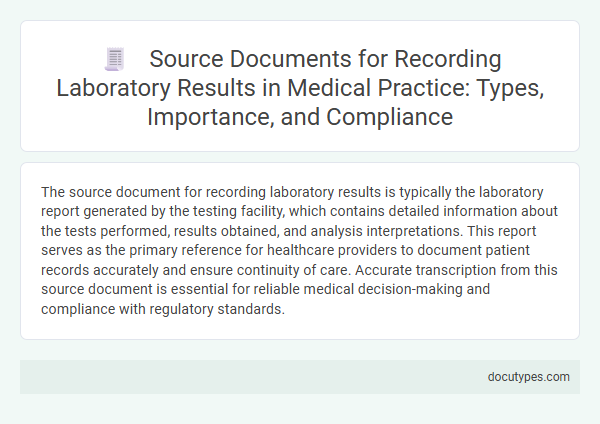The source document for recording laboratory results is typically the laboratory report generated by the testing facility, which contains detailed information about the tests performed, results obtained, and analysis interpretations. This report serves as the primary reference for healthcare providers to document patient records accurately and ensure continuity of care. Accurate transcription from this source document is essential for reliable medical decision-making and compliance with regulatory standards.
Introduction to Laboratory Source Documents in Medical Practice
Laboratory source documents are essential records used to capture and verify laboratory test results in medical practice. These documents serve as the primary foundation for accurate data entry, patient diagnosis, and treatment decisions.
- Definition of Laboratory Source Documents - These documents include laboratory notebooks, test requisitions, and electronic health records that record raw data and observations directly from laboratory tests.
- Role in Medical Practice - Source documents ensure the reliability and traceability of laboratory results, supporting clinical decision-making and regulatory compliance.
- Types of Laboratory Source Documents - Common types involve printed lab reports, digital data entries, and quality control logs documenting procedural and result validation.
Types of Source Documents Used for Laboratory Results
The source document for recording laboratory results is the original record where test data is first captured. It ensures accuracy and traceability in medical records management.
Types of source documents used for laboratory results include paper laboratory reports, electronic health records (EHR), and laboratory information system (LIS) printouts. Paper laboratory reports contain handwritten or printed test outcomes directly from the lab. Electronic health records integrate lab data within patient files for seamless access and analysis.
Paper-Based vs. Electronic Laboratory Records
The source document for recording laboratory results serves as the original record capturing all test data. It plays a critical role in ensuring accurate and verifiable patient information.
- Paper-Based Laboratory Records - Physical forms, such as test requisitions and printed reports, are used to document results and signatures manually.
- Electronic Laboratory Records - Digital platforms store test results directly from laboratory instruments, offering enhanced data accessibility and integration.
- Data Integrity and Accuracy - Both systems prioritize secure and accurate data entry, but electronic records reduce transcription errors and improve traceability.
Your choice between paper-based and electronic sources impacts the efficiency and reliability of laboratory documentation.
Essential Elements in Laboratory Documentation
The source document for recording laboratory results is the original laboratory report or test record generated during the analysis process. This document contains critical data such as patient identification, test type, specimen details, and numerical or qualitative results.
Essential elements in laboratory documentation include accurate patient information, test method descriptions, result values, reference ranges, date and time of specimen collection, and analyst identification. You must ensure these components are complete to maintain data integrity and support clinical decision-making.
Importance of Accurate Source Documentation in Healthcare
What is the source document for recording laboratory results? The source document is the original record where laboratory results are first documented, such as lab reports or electronic health records (EHRs). Accurate source documentation ensures reliable patient data, supporting effective diagnosis and treatment decisions.
Legal and Regulatory Requirements for Laboratory Records
The source document for recording laboratory results is a critical element in ensuring accuracy and traceability in medical testing. Legal and regulatory requirements mandate that these documents are thorough, secure, and readily accessible to safeguard patient information and support clinical decisions.
These records must comply with standards set by agencies such as the Clinical Laboratory Improvement Amendments (CLIA) and the Food and Drug Administration (FDA). Proper documentation practices help maintain the integrity of laboratory results and facilitate audits and inspections.
- Retention of Records - Laboratory records must be retained for a specific duration, often defined by regulatory bodies, to ensure availability for review and legal purposes.
- Accuracy and Completeness - Source documents must accurately reflect the test procedures and results without alterations to maintain data integrity.
- Confidentiality and Security - Access to laboratory records must be controlled to protect patient privacy and comply with regulations such as HIPAA.
Role of Source Documents in Clinical Decision-Making
The source document for recording laboratory results is the original report generated by the laboratory, which contains detailed test data and measurements. These documents serve as a critical reference for verifying the accuracy and authenticity of patient diagnostic information. In clinical decision-making, source documents ensure reliable data input, guiding physicians in developing appropriate treatment plans and monitoring patient progress effectively.
Ensuring Data Integrity and Confidentiality
The source document for recording laboratory results is the original record where test outcomes are first documented, such as laboratory notebooks, electronic health records (EHR), or laboratory information systems (LIS). These documents serve as the primary evidence for patient diagnosis and treatment decisions.
Ensuring data integrity involves accurate, timely, and consistent recording of laboratory results without unauthorized alterations. Confidentiality is maintained through secure access controls, encryption, and compliance with regulations like HIPAA to protect patient information from unauthorized disclosure.
Common Challenges in Maintaining Laboratory Records
| Topic | Details |
|---|---|
| Source Document for Recording Laboratory Results | The primary source document for recording laboratory results is the laboratory report. This document contains detailed information on specimen identification, test performed, methodology, result values, reference ranges, and interpretation notes. Source documents may also include electronic laboratory information systems (LIS) entries and original printouts from analyzers. |
| Common Challenges in Maintaining Laboratory Records |
|
What Is the Source Document for Recording Laboratory Results? Infographic

